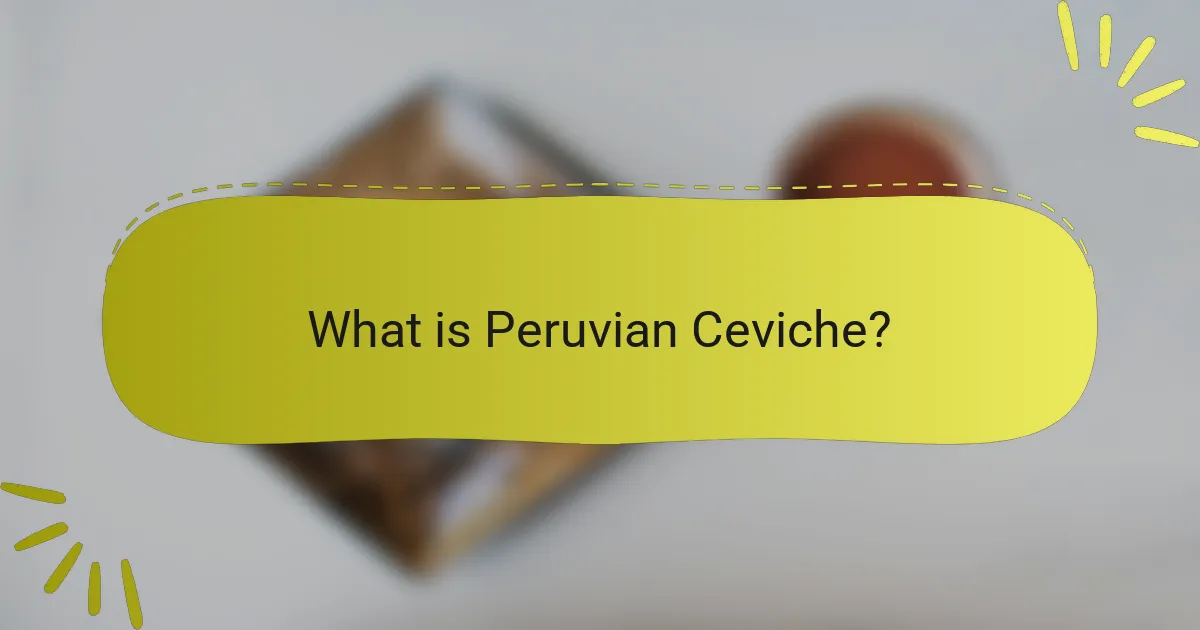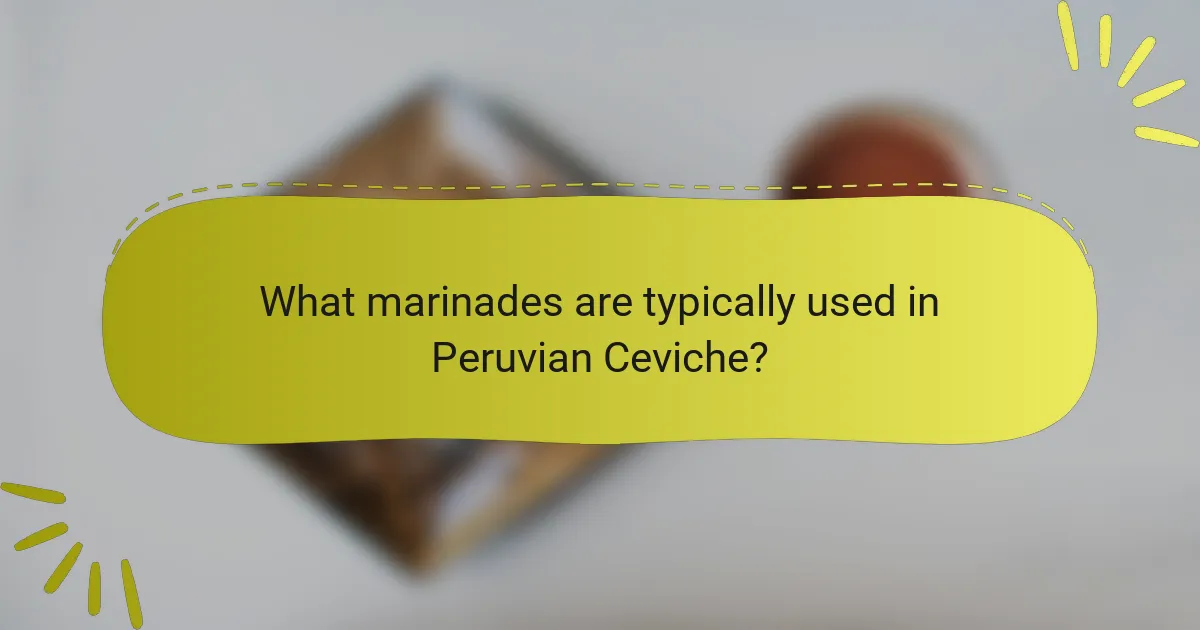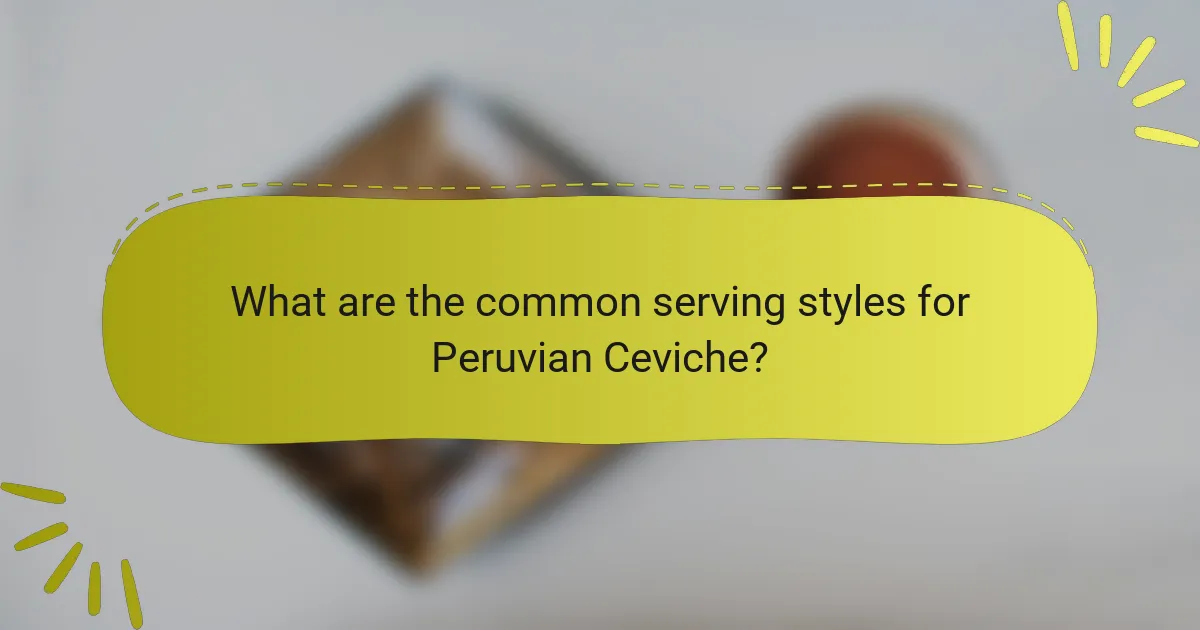Peruvian ceviche is a traditional dish featuring fresh raw fish marinated in citrus juices, primarily lime, and seasoned with salt, onions, and chili peppers. This dish, a staple of Peruvian cuisine, is known for its bright flavors and is often accompanied by side dishes such as sweet potatoes, corn, or lettuce. The marination process, which involves the acidity of lime juice, effectively “cooks” the fish, making it safe to eat. Various fish varieties, including corvina, tilapia, and sole, contribute to the unique flavor profile of ceviche. Additionally, the marinade known as “leche de tigre” enhances the dish’s taste with ingredients like cilantro, garlic, and ginger. Serving styles range from traditional bowls to elegant plates and even taco formats, reflecting the rich culinary heritage and regional diversity of Peru.

What is Peruvian Ceviche?
Peruvian ceviche is a traditional dish made from fresh raw fish marinated in citrus juices, primarily lime. It is often seasoned with salt, onions, and chili peppers. The dish is known for its bright flavors and is a staple of Peruvian cuisine. Ceviche is typically served with side dishes like sweet potatoes, corn, or lettuce. The marination process “cooks” the fish through the acidity of the citrus. This culinary method has deep roots in Peru, dating back to ancient times. The use of fresh ingredients is crucial for authentic ceviche.
How is Peruvian Ceviche traditionally prepared?
Peruvian ceviche is traditionally prepared by marinating fresh fish in citrus juices, primarily lime. The fish is typically cut into small cubes. The marinade is made with freshly squeezed lime juice, which “cooks” the fish through acidity. Additional ingredients include finely chopped onions and cilantro. Chili peppers are often added for heat. The dish is usually served cold, often accompanied by sides like sweet potatoes and corn. This preparation method emphasizes freshness and simplicity, integral to authentic Peruvian ceviche.
What are the key ingredients in Peruvian Ceviche?
The key ingredients in Peruvian Ceviche are fresh fish, lime juice, red onion, cilantro, and chili peppers. Fresh fish, typically firm white fish like sea bass or tilapia, is essential for the dish. Lime juice is used to marinate the fish and “cook” it through acidity. Red onion adds a sharp flavor and crunch. Cilantro contributes a fresh herbal note. Chili peppers, such as ají amarillo, provide heat and depth. These ingredients combine to create a vibrant and flavorful dish that is a staple of Peruvian cuisine.
How does the marination process work in Ceviche?
Ceviche is marinated by soaking raw fish in citrus juices, primarily lime or lemon. The acidity of the juice denatures the proteins in the fish. This process effectively “cooks” the fish without heat. Typically, the fish is cut into small pieces to ensure even marination. The marination time can vary from 15 minutes to several hours. Shorter marination results in a firmer texture. Longer marination leads to a more opaque and tender fish. Additional ingredients like onions, cilantro, and chili peppers are often added for flavor. The marination process is crucial for both taste and food safety in ceviche.
What makes Peruvian Ceviche unique compared to other ceviche styles?
Peruvian ceviche is unique due to its use of fresh, high-quality fish, typically corvina or sole. The fish is cured in freshly squeezed lime juice, which is essential for its flavor. This method is distinct from other ceviche styles that may use vinegar or different citrus. Additionally, Peruvian ceviche often includes ingredients like red onions, cilantro, and aji peppers, enhancing its taste profile. The dish is traditionally served with sides such as sweet potato and corn, adding texture and sweetness. This combination of ingredients and preparation methods sets Peruvian ceviche apart from other regional variations.
What cultural influences shape Peruvian Ceviche?
Peruvian ceviche is shaped by indigenous, Spanish, and Asian cultural influences. The indigenous people contributed local fish and traditional preparation methods. Spanish colonization introduced citrus fruits, particularly lime, which are essential for marinating the fish. Asian immigrants, especially from Japan and China, influenced ceviche with new ingredients and techniques. For instance, the addition of soy sauce and ginger reflects this Asian impact. These combined cultural elements create the unique flavors and styles of modern Peruvian ceviche.
How do regional variations affect the preparation of Ceviche?
Regional variations significantly influence the preparation of ceviche. Different regions utilize local fish species, which affects flavor and texture. For instance, coastal areas in Peru may prefer the use of fresh corvina. In contrast, regions with access to different waters might use tilapia or other local fish.
Marinades also vary by region, with some areas incorporating unique ingredients like mango or rocoto pepper. The acidity level from lime juice can differ based on local preferences, impacting the dish’s overall taste.
Serving styles can reflect cultural traditions, with some regions presenting ceviche with sweet potatoes or corn. These variations highlight the diversity of ceviche across different locales, showcasing how local resources shape culinary practices.

What are the different fish varieties used in Peruvian Ceviche?
Peruvian ceviche commonly uses several fish varieties. The most popular include corvina, which is a white fish known for its firm texture. Another frequently used fish is tilapia, appreciated for its mild flavor. Additionally, sole is often included for its delicate taste. Other varieties may include flounder and mahi-mahi, both of which contribute to the dish’s unique flavor profile. These fish are typically fresh and served raw, marinated in lime juice and accompanied by various ingredients. The choice of fish can vary by region and personal preference, enhancing the diversity of ceviche in Peruvian cuisine.
Which fish are most commonly used in traditional recipes?
The fish most commonly used in traditional recipes, particularly in Peruvian ceviche, include sole, tilapia, and corvina. Sole is favored for its mild flavor and tender texture. Tilapia is widely available and has a firm flesh that holds up well in marinades. Corvina, a white fish, is often regarded as the best choice for ceviche due to its delicate taste and flaky consistency. These fish are integral to authentic ceviche preparations, highlighting their importance in traditional culinary practices.
What are the flavor profiles of these fish varieties?
The flavor profiles of various fish used in Peruvian ceviche are distinct and diverse. For instance, sea bass has a mild, sweet flavor with a firm texture. This makes it a popular choice for ceviche. Similarly, tilapia offers a delicate taste that absorbs marinades well. It is often used for its availability and mild profile.
Another variety, mackerel, has a rich, oily flavor that adds depth to the dish. Its stronger taste contrasts with lighter fish. Additionally, flounder is known for its subtle sweetness and tender texture, enhancing the overall ceviche experience.
Finally, shrimp, while not a fish, is commonly included and provides a slightly sweet and briny flavor. Each variety contributes unique characteristics, making ceviche a complex and flavorful dish.
How does the choice of fish impact the overall dish?
The choice of fish significantly impacts the overall dish of ceviche. Different fish varieties offer unique flavors and textures. For instance, firm fish like corvina provide a meaty bite, while softer fish like tilapia create a delicate experience. The freshness of the fish also affects the dish’s quality. Fresh fish enhances the ceviche’s flavor profile and overall appeal. Additionally, the fat content in fish influences the dish’s richness. Oily fish like mackerel add depth, while lean fish maintain a lighter taste. Ultimately, the chosen fish determines the ceviche’s taste, texture, and visual presentation.
Are there any sustainable fish options for making Ceviche?
Yes, there are sustainable fish options for making ceviche. Fish such as mackerel, sardines, and anchovies are considered sustainable choices. These species are abundant and often caught using methods that minimize environmental impact. According to the Marine Stewardship Council, these fish are harvested from well-managed fisheries. Additionally, using farmed fish like tilapia or barramundi can also be sustainable, provided they are sourced from responsible aquaculture operations. These options help ensure the preservation of marine ecosystems while still allowing for delicious ceviche preparation.
What are the criteria for sustainable fish choices?
Sustainable fish choices are determined by several criteria. These include the fish’s population status, which should be healthy and not overfished. Fishing methods must be environmentally responsible, minimizing bycatch and habitat damage. The fish should be sourced from well-managed fisheries or aquaculture operations. Certification from organizations like the Marine Stewardship Council (MSC) or the Aquaculture Stewardship Council (ASC) is a key indicator of sustainability. Additionally, the ecological impact of harvesting the fish must be considered, ensuring it does not harm the ecosystem. Awareness of the fish’s origin and adherence to local regulations further contribute to sustainable choices.
How can consumers identify sustainable fish sources?
Consumers can identify sustainable fish sources by checking for certifications like the Marine Stewardship Council (MSC) label. These certifications ensure that fish are sourced from well-managed fisheries. Another method is to consult sustainability guides from organizations like Seafood Watch. These guides categorize fish species based on their environmental impact. Additionally, consumers can ask retailers about the origin of the fish and the fishing practices used. Transparency in sourcing is a key indicator of sustainability. Research indicates that sustainable fisheries help maintain fish populations and ecosystems, making informed choices crucial for environmental health.

What marinades are typically used in Peruvian Ceviche?
Peruvian ceviche typically uses a marinade called “leche de tigre.” This marinade consists primarily of fresh lime juice, which is essential for the dish. Additionally, it often includes ingredients like cilantro, garlic, and chili peppers. The acidity of the lime juice “cooks” the fish, making it safe to eat. Other common ingredients in the marinade can include ginger and onion. These elements enhance the flavor profile of the ceviche. The combination of these ingredients creates a vibrant and refreshing dish, characteristic of Peruvian cuisine.
What ingredients are essential for a classic Ceviche marinade?
The essential ingredients for a classic Ceviche marinade include fresh lime juice, salt, and sliced onions. Fresh lime juice is crucial as it “cooks” the fish through acidity. Salt enhances flavor and helps in drawing moisture from the fish. Sliced onions add a crunchy texture and a sharp taste that complements the dish. Additionally, cilantro is often included for its fresh flavor. These ingredients create a balanced and flavorful marinade that is characteristic of traditional Ceviche.
How does lime juice play a role in the marinade?
Lime juice is a crucial component in marinades, particularly in ceviche. It acts as a natural acid that denatures proteins in fish. This process alters the fish’s texture, making it firmer and more palatable. Lime juice also imparts a distinct tangy flavor that enhances the overall taste of the dish. The acidity in lime juice helps to kill harmful bacteria, making the fish safer to consume. Additionally, lime juice can help to balance other flavors in the marinade, such as herbs and spices. The use of lime juice in ceviche is a traditional practice, rooted in Peruvian culinary culture.
What additional flavors can enhance the marinade?
Citrus juices, such as lime and orange, can enhance the marinade. They provide acidity that brightens flavors. Fresh herbs like cilantro and parsley add aromatic notes. Garlic and ginger introduce depth and warmth. Spices like cumin and paprika contribute earthy undertones. Soy sauce can add umami richness to the mix. Honey or sugar balances acidity with sweetness. These flavors create a well-rounded marinade for ceviche.
How do variations in marinades affect the taste of Ceviche?
Variations in marinades significantly affect the taste of ceviche. Different types of citrus, such as lime or lemon, can alter the acidity level. Higher acidity can enhance the freshness of the fish. The addition of ingredients like cilantro or chili can introduce herbal or spicy notes. Sweet elements, such as mango or honey, can balance the acidity and add complexity. Marinade duration also impacts flavor absorption in the fish. Longer marination can intensify the overall taste profile. Each marinade variation creates a unique ceviche experience tailored to personal preference.
What are some popular alternative marinades used in Ceviche?
Popular alternative marinades used in ceviche include lime juice, orange juice, and coconut milk. Lime juice is the traditional marinade that “cooks” the fish through acidity. Orange juice adds sweetness and a different flavor profile. Coconut milk provides a creamy texture and tropical taste. Other alternatives include vinegar-based marinades and tomato-based sauces. These variations allow for creative adaptations while maintaining the essence of ceviche. Each marinade influences the overall flavor and texture of the dish.
How do different herbs and spices contribute to the flavor?
Different herbs and spices enhance the flavor of dishes by adding distinct aromas and taste profiles. Herbs like cilantro provide a fresh, citrusy note that complements seafood. Spices such as cumin offer earthy and warm undertones, enriching the overall flavor. The combination of these elements can create a balanced and complex taste experience. For example, in Peruvian ceviche, the use of garlic adds depth, while chili peppers introduce heat. These contributions are essential for elevating the dish and making it more enjoyable.

What are the common serving styles for Peruvian Ceviche?
Common serving styles for Peruvian ceviche include traditional presentations and contemporary variations. The classic style typically features ceviche served in a bowl with side accompaniments. These accompaniments often include sweet potatoes, corn, and lettuce. Another common style is serving ceviche on a plate, allowing for a more elegant presentation. Additionally, some restaurants offer ceviche in a taco format, using tortillas. Each style emphasizes the freshness of the fish and the tangy marinade. The traditional serving often highlights the use of lime juice and onions as key ingredients. These serving styles reflect Peru’s culinary heritage and regional variations.
How is Peruvian Ceviche typically presented?
Peruvian ceviche is typically presented in a bowl or a deep plate. The dish usually features marinated fish, often garnished with slices of red onion. It is often accompanied by sides such as sweet potato or corn. The presentation may also include fresh cilantro for added flavor. Lemon or lime wedges are sometimes placed on the side. This serving style highlights the vibrant colors and freshness of the ingredients. The dish is traditionally served chilled, enhancing its refreshing qualities.
What garnishes are commonly used with Ceviche?
Common garnishes used with ceviche include sliced avocado, cilantro, and red onion. These garnishes enhance the dish’s flavor and presentation. Avocado adds creaminess and richness. Cilantro provides a fresh, herbal note. Red onion contributes a sharp, tangy taste. Other popular garnishes are lime wedges and chili peppers. Lime wedges offer additional acidity. Chili peppers add heat and spice. These garnishes are traditional in Peruvian ceviche. They complement the marinated fish and overall dish beautifully.
What side dishes accompany Ceviche in traditional meals?
Ceviche is traditionally accompanied by side dishes such as sweet potatoes, corn, and avocado. Sweet potatoes provide a sweet contrast to the acidity of the ceviche. Corn, particularly Peruvian giant corn, adds a crunchy texture. Avocado offers creaminess that balances the dish. These accompaniments enhance the overall flavor profile and are commonly served in Peru.
What are some modern twists on serving Peruvian Ceviche?
Modern twists on serving Peruvian ceviche include variations like tropical fruit additions, unique garnishes, and alternative proteins. Chefs often incorporate mango or pineapple to enhance sweetness. Some versions feature avocado for creaminess. Others serve ceviche in taco form, using tortillas as a base. Quinoa is sometimes added for texture and nutrition. Creative presentations include ceviche served in martini glasses or jars. These modern interpretations maintain traditional flavors while introducing new elements. This approach reflects contemporary culinary trends and enhances visual appeal.
How have chefs innovated traditional serving styles?
Chefs have innovated traditional serving styles by incorporating modern presentation techniques. They often use deconstruction to highlight individual ingredients in ceviche. This approach allows diners to appreciate each component’s flavor and texture. Additionally, chefs have embraced unique plating styles, such as using glassware or edible containers. This elevates the dining experience and adds visual appeal. Furthermore, fusion cuisine has influenced ceviche serving styles, blending elements from other cultures. For example, some chefs serve ceviche with Asian-inspired garnishes or sauces. These innovations enhance traditional recipes while maintaining their cultural essence.
What fusion dishes incorporate Ceviche elements?
Ceviche elements are incorporated into various fusion dishes. Examples include ceviche tacos, which combine traditional ceviche with taco shells. Another example is ceviche sushi, blending Japanese sushi techniques with Peruvian ceviche flavors. Ceviche bowls feature ceviche served over rice or quinoa, integrating elements from poke bowls. Additionally, ceviche nachos use tortilla chips topped with ceviche, merging Mexican and Peruvian cuisines. These dishes highlight the versatility of ceviche in global culinary contexts.
What tips can enhance the experience of enjoying Peruvian Ceviche?
To enhance the experience of enjoying Peruvian ceviche, serve it immediately after preparation. Freshness is crucial for optimal flavor and texture. Use high-quality fish like corvina or tilapia, as they provide the best taste. Marinate the fish in freshly squeezed lime juice for about 15-20 minutes. This duration allows the fish to “cook” properly without becoming overly firm. Pair ceviche with side dishes like sweet potato or corn to complement its acidity. Garnish with fresh cilantro and thinly sliced red onions for added flavor. Enjoy the dish chilled to enhance its refreshing qualities. Lastly, consider serving it in a traditional bowl for an authentic experience.
How can one select the freshest ingredients for Ceviche?
To select the freshest ingredients for ceviche, prioritize fish that is firm and has a clean ocean scent. Fresh fish should have bright, clear eyes and shiny skin. Check for any discoloration or dullness, which may indicate age. Additionally, ensure the fish feels moist to the touch, not slimy. For other ingredients, choose vibrant, firm vegetables like onions and peppers. Fresh herbs should be bright green and aromatic. The quality of lime juice is also crucial; use freshly squeezed juice for optimal flavor. According to the Seafood Watch program, sourcing fish from sustainable fisheries can also ensure freshness and quality.
What are the best practices for marinating fish at home?
The best practices for marinating fish at home include using fresh ingredients, balancing flavors, and timing the marination process correctly. Fresh fish enhances flavor and texture. Common marinade ingredients are citrus juice, herbs, and spices. Citrus juice, such as lime or lemon, tenderizes fish and adds acidity. Herbs like cilantro or parsley complement the dish. Use a non-reactive container, such as glass or ceramic, to prevent chemical reactions. Marinate fish for 30 minutes to 2 hours, depending on the thickness of the fillet. Over-marinating can lead to a mushy texture. Always refrigerate the fish while marinating to prevent bacterial growth. Rinse off excess marinade before cooking to avoid overpowering flavors.
Peruvian ceviche is a traditional dish featuring fresh raw fish marinated in citrus juices, primarily lime, and seasoned with ingredients like salt, onions, and chili peppers. This article explores various aspects of Peruvian ceviche, including the traditional preparation methods, key ingredients such as different fish varieties, and the marination process that “cooks” the fish through acidity. Additionally, it examines the cultural influences shaping ceviche, regional variations, sustainable fish options, and common serving styles. The article also highlights popular marinades and garnishes that enhance the dish’s flavor profile, providing a comprehensive overview of this staple of Peruvian cuisine.